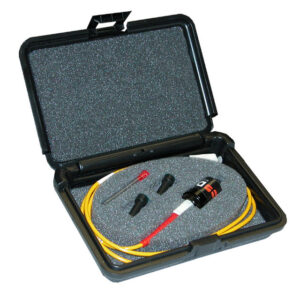目录
ToggleBare fiber adapters play an important role in fiber optic networks, providing a temporary connection point for testing and splicing fibers without requiring full termination. These adapters offer a convenient and efficient solution for technicians working with fiber optic cables, especially in testing environments. In this article, we’ll explore the advantages, applications, and key considerations when using a bare fiber adapter.
What Is a Bare Fiber Adapter?
A bare fiber adapter is a device that temporarily connects bare optical fibers to testing equipment or other fibers without the need for permanent connectors. It is designed to securely hold the exposed fiber in place, creating a stable connection point for testing signal strength, alignment, and performance. This tool is particularly useful in situations where fibers need to be tested before they are permanently terminated, allowing technicians to work with ease and precision.
By using a bare fiber adapter, technicians can save time and resources, as there is no need to fully terminate a fiber just to perform a quick test. The convenience of connecting and disconnecting fibers quickly is one of the primary benefits of this adapter.

Key Advantages of Bare Fiber Adapters
Bare fiber adapters offer several key advantages, starting with convenience. They are designed for quick and easy use, allowing technicians to test fibers on the go without needing complex tools. This flexibility makes them ideal for fieldwork, where quick testing can speed up troubleshooting and repair tasks.
Another advantage of bare fiber adapters is their ability to prevent fiber damage. When fibers are stripped for testing, they are vulnerable to dust, dirt, and physical damage. A bare fiber adapter protects the fiber by holding it securely, minimizing the risk of accidental damage that can impair performance. Additionally, the adapter ensures proper alignment, which is essential for accurate signal testing.
The cost-effectiveness of bare fiber adapters also makes them appealing. Since they eliminate the need for full termination in temporary testing situations, they reduce the overall expense and effort involved in setting up tests. This is particularly beneficial for technicians who frequently work with multiple fibers and need a reliable way to test connections without the time and cost of permanent terminations.
Common Applications of Bare Fiber Adapters
Bare fiber adapters are widely used in testing environments, particularly during the installation and maintenance of fiber optic networks. When a technician is installing a new fiber line, they often use a bare fiber adapter to test the signal before permanent splicing or termination. This ensures that the fiber is performing as expected, reducing the likelihood of issues down the line.
These adapters are also useful in troubleshooting network issues. By quickly testing fiber lines with a bare fiber adapter, technicians can identify breaks, weak signals, or misalignments. This rapid testing capability is essential for minimizing network downtime and ensuring consistent performance across the system.
In laboratories and research facilities, bare fiber adapters are frequently used in experimental setups where fibers need to be connected and disconnected regularly. Since these adapters provide a temporary connection, they are perfect for situations that require repeated testing or adjustments.
Choosing the Right Bare Fiber Adapter
When selecting a bare fiber adapter, it’s important to consider factors like compatibility, build quality, and ease of use. Compatibility is essential; the adapter should support the fiber type and size you are working with to ensure accurate testing results. Some bare fiber adapters are designed specifically for single-mode or multimode fibers, so choosing the right one for your application is crucial.
Build quality is another important consideration. A well-constructed bare fiber adapter will provide a stable connection and protect the fiber from dust, dirt, and damage. Look for adapters made from durable materials that can withstand repeated use, especially if you work in demanding field environments.
Ease of use should not be overlooked. A good bare fiber adapter should allow you to secure the fiber easily and adjust it as needed. Since the primary function of this tool is to enable quick and temporary testing, it’s essential to choose a design that simplifies the process.
The Future of Bare Fiber Adapters in Fiber Optic Testing
As fiber optic technology continues to advance, bare fiber adapters remain an essential tool for technicians and researchers. The growing demand for high-speed networks and data-driven applications increases the need for reliable testing tools, and bare fiber adapters provide an efficient way to ensure fiber quality and performance.
With improvements in design and functionality, future bare fiber adapters are likely to become even more user-friendly and versatile. Some innovations may focus on enhanced dust protection, while others could introduce built-in alignment features to improve test accuracy. These advancements will further support technicians in delivering reliable and efficient fiber optic services.
In summary, bare fiber adapters are invaluable for fiber optic testing and maintenance. Their convenience, cost-effectiveness, and adaptability make them a go-to solution for technicians working in a variety of environments. Whether used for installation, troubleshooting, or lab testing, bare fiber adapters contribute to the success of fiber optic networks by enabling quick and accurate testing.
0